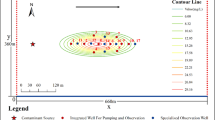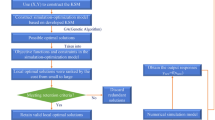Abstract
A stochastic optimization model based on an adaptive feedback correction process and surrogate model uncertainty was proposed and applied for remediation strategy design at a dense non-aqueous phase liquids (DNAPL)-contaminated groundwater site. One hundred initial training samples were obtained using the Latin hypercube sampling method. A surrogate model of a multiphase flow simulation model was constructed based on these samples employing the self-adaptive particle swarm optimization kriging (SAPSOKRG) method. An optimization model was built, using the SAPSOKRG surrogate model as a constraint. Then, an adaptive feedback correction process was designed and applied to iteratively update the training samples, surrogate model, and optimization model. Results showed that the training samples, the surrogate model, and the optimization model were effectively ameliorated. However, the surrogate model is an approximation of the simulation model, and some degree of uncertainty exists even though the surrogate model was ameliorated. Therefore, residuals between the surrogate model and the simulation model were calculated, and an uncertainty analysis was conducted. Based on the uncertainty analysis results, a stochastic optimization model was constructed and solved to obtain optimal remediation strategies at different confidence levels (60, 70, 80, 90, 95%) and under different remediation objectives (average DNAPL removal rate ≥ 70, ≥ 75, ≥ 80, ≥ 85, ≥ 90%). The optimization results demonstrated that the higher the confidence level and remediation objective, the more expensive was remediation. Therefore, decision makers can weigh remediation costs, confidence levels, and remediation objectives to make an informed choice. This also allows decision makers to determine the reliability of a selected strategy and provides a new tool for DNAPL-contaminated groundwater remediation design.







Similar content being viewed by others
References
Acar E, Rais-Rohani M (2009) Ensemble of metamodels with optimized weight factors. Structruct Multidiscip Optim 37(3):279–294
Ahlfeld DP, Mulvey MJ, Pinder GF et al (1988) Contaminated groundwater remediation design using simulation, optimization and sensitivity theory model development. Water Resour Res 24(3):431–441
Ayvaz TM (2016) A hybrid simulation—optimization approach for solving the areal groundwater pollution source identification problems. J Hydrol 538:161–176
Bajpai P, Kumar DRM (2000) Genetic algorithm—an approach to solve global optimization problems. Indian J Comput Sci Eng 1(3):199–206
Ciriello V, Di Federico V, Riva M et al (2013) Polynomial chaos expansion for global sensitivity analysis applied to a model of radionuclide migration in a randomly heterogeneous aquifer. Stoch Environ Res Risk Assess 27:945–954
Ciriello V, Lauriola I, Bonvicini S et al (2017) Impact of hydrogeological uncertainty on estimation of environmental risks posed by hydrocarbon transportation networks. Water Resour Res 53:8686–8697
Coulon F, Orsi R, Turner C et al (2009) Understanding the fate and transport of petroleum hydrocarbons from coal tar within gasholders. Environ Int 35(2):248–252
Datta B, Prakash O, Sreekanth J (2014) Application of genetic programming models incorporated in optimization models for contaminated groundwater systems management. In: Tantar A-A et al (eds) EVOLVE-a bridge between probability, set oriented numerics, and evolutionary computation V. Springer, Berlin, pp 183–199
Davey KR (2008) Latin hypercube sampling and pattern search in magnetic field optimization problems. IEEE Trans Magn 44(6):974–977
Delshad M, Pope GA, Sepehrnoori K (1996) A compositional simulator for modeling surfactant enhanced aquifer remediation, 1 formulation. J Contam Hydrol 23(4):303–327
Forrester AIJ, Keane AJ (2009) Recent advances in surrogate-based optimization. Prog Aerosp Sci 45(1):50–79
Guénot M, Lepot I, Sainvitu C et al (2013) Adaptive sampling strategies for non-intrusive POD-based surrogates. Eng Comput 30(4):521–547
He L, Huang GH, Lu HW et al (2008) Optimization of surfactant-enhanced aquifer remediation for a laboratory BTEX system under parameter uncertainty. Environ Sci Technol 42(6):2009–2014
He L, Huang GH, Lu HW (2009) A coupled simulation–optimization approach for groundwater remediation design under uncertainty: an application to a petroleum-contaminated site. Environ Pollut 157:2485–2492
Hou ZY, Lu WX, Chu HB et al (2015) Selecting parameter-optimized surrogate models in DNAPL-contaminated aquifer remediation strategies. Environ Eng Sci 32(12):1016–1026
Hou ZY, Lu WX, Chen M (2016) Surrogate-based sensitivity analysis and uncertainty analysis for dnapl-contaminated aquifer remediation. J Water Resour Plan Manag 142(11):04016043
Janusevskis J, Le Riche R (2013) Simultaneous kriging-based estimation and optimization of mean response. J Glob Optim 55(2):313–336
Jarque CM, Bera AK (1980) Efficient tests for normality, homoscedasticity and serial independence of regression residuals. Econ Lett 6(3):255–259
Jiang X, Lu WX, Hou ZY et al (2015) Ensemble of surrogates-based optimization for identifying an optimal surfactant-enhanced aquifer remediation strategy at heterogeneous DNAPL-contaminated sites. Comput Geosci 84:37–45
Lee JS, Kang SK (2007) GA based meta-modeling of BPN architecture for constrained approximate optimization. Int J Solids Struct 44:5980–5993
Lee SH, Kim HY, Oh SI (2002) Cylindrical tube optimization using response surface method based on stochastic process. J Mater Process Technol 130:490–496
Lozzo MD, Marrel A (2017) Sensitivity analysis with dependence and variance-based measures for spatio-temporal numerical simulators. Stoch Env Res Risk Assess 31(6):1437–1453
Luo JN, Lu WX (2014a) Sobol’ sensitivity analysis of NAPL-contaminated aquifer remediation process based on multiple surrogates. Comput Geosci 67:110–116
Luo JN, Lu WX (2014b) A mixed-integer non-linear programming with surrogate model for optimal remediation design of napls contaminated aquifer. Int J Environ Pollut 54(1):1–16
Luo JN, Lu WX (2014c) Comparison of surrogate models with different methods in groundwater remediation process. J Earth Syst Sci 123(7):1579–1589
Luo JN, Lu WX, Xin X et al (2013) Surrogate model application to the identification of an optimal surfactant-enhanced aquifer remediation strategy for DNAPL-contaminated sites. J Earth Sci 24(6):1023–1032
Mason AR, Kueper BH (1996) Numerical simulation of surfactant flooding to remove pooled DNAPL from porous media. Environ Sci Technol 30(11):3205–3215
NRC (National Research Council) (1994) Alternatives for Groundwater Cleanup. National Academy Press, Washington, DC
Oenema J, Burgers S, van Keulen H et al (2015) Stochastic uncertainty and sensitivities of nitrogen flows on dairy farms in The Netherlands. Agric Syst 137:126–138
Piscopo AN, Neupauer RM, Kasprzyk JR (2016) Optimal design of active spreading systems to remediate sorbing groundwater contaminants in situ. J Contam Hydrol 190:29–43
Qin XS, Huang GH, Chakma A et al (2007) Simulation-based process optimization for surfactant-enhanced aquifer remediation at heterogeneous DNAPL-contaminated sites. Sci Total Environ 381(1–3):17–37
Qin XS, Huang GH, He L (2009) Simulation and optimization technologies for petroleum waste management and remediation process control. J Environ Manag 90(1):54–76
Queipo NV, Haftka RT, Shyy W et al (2005) Surrogate-based analysis and optimization. Prog Aerosp Sci 41:1–28
Rathfelder KM, Abriola LM, Taylor TP et al (2001) Surfactant enhanced recovery of tetrachloroethylene from a porous medium containing low permeability lenses: 2. Numerical simulation. J Contam Hydrol 48(3):351–374
Rogers LL, Dowla FU, Johnson VM (1995) Optimal field-scale groundwater remediation using neural networks and the genetic algorithm. Environ Sci Technol 29(5):1145–1155
Roy PT, Moçayd NE, Ricci S et al (2017) Comparison of polynomial chaos and gaussian process surrogates for uncertainty quantification and correlation estimation of spatially distributed open-channel steady flows. Stoch Env Res Risk Assess. https://doi.org/10.1007/s00477-017-1470-4
Schaerlaekens J, Mertens J, van Linden J et al (2006) A multi-objective optimization framework for surfactant-enhanced remediation of DNAPL contaminations. J Contam Hydrol 86(3–4):176–194
Singh A (2012) An overview of the optimization modelling applications. J Hydrol 466:167–182
Smola AJ, Schölkopf B (2004) A tutorial on support vector regression. Stat Comput 14(3):199–222
Sreekanth J, Datta B (2011a) Coupled simulation–optimization model for coastal aquifer management using genetic programming-based ensemble surrogate models and multiple-realization optimization. Water Resour Res 47(4):158–166
Sreekanth J, Datta B (2011b) Optimal combined operation of production and barrier wells for the control of saltwater intrusion in coastal groundwater well fields. Desalination Water Treat 32(1–3):72–78
Sreekanth J, Datta B (2015) Review: simulation–optimization models for the management and monitoring of coastal aquifers. Hydrogeol J 23(6):1155–1166
Wang FK, Huang PR (2014) Implementing particle swarm optimization algorithm to estimate the mixture of two Weibull parameters with censored data. J Stat Comput Simul 84(9):1975–1989
Wang S, Huang GH, He L (2012) Development of a clusterwise-linear-regression-based forecasting system for characterizing DNAPL dissolution behaviors in porous media. Sci Total Environ 433:141–150
Wang YY, Huang GH, Wang S (2017) Cvar-based factorial stochastic optimization of water resources systems with correlated uncertainties. Stoch Env Res Risk Assess 31(6):1543–1553
Xu C, He HS, Hu Y et al (2005) Latin hypercube sampling and geostatistical modeling of spatial uncertainty in a spatially explicit forest landscape model simulation. Ecol Model 185(2):255–269
Xu Q, Wehrle E, Baier H (2012) Adaptive surrogate-based design optimization with expected improvement used as infill criterion. Optimization 61(6):661–684
Zhang Y (2009) Research on lightweight design of autobody structure using robust and reliability-based design optimization, Shanghai Jiao Tong University (In Chinese)
Zhang D, Shi L, Chang H et al (2010) A comparative study of numerical approaches to risk assessment of contaminant transport. Stoch Env Res Risk Assess 24(7):971–984
Zhao Y, Lu WX, An YK (2015) Surrogate model-based simulation-optimization approach for groundwater source identification problems. Environ Forensics 16(3):296–303
Zhao Y, Lu WX, Xiao CN (2016) A kriging surrogate model coupled in simulation–optimization approach for identifying release history of groundwater sources. J Contam Hydrol 185–186(Pt2):225–236
Acknowledgements
This study was supported by Project funded by China Postdoctoral Science Foundation (No. 2016M602388), the National Key Research and Development Program of China (2016YFC0402803-02) and the National Natural Science Foundation of China (No. 41372237 and No. 41521001).
Author information
Authors and Affiliations
Corresponding authors
Rights and permissions
About this article
Cite this article
Jiang, X., Lu, W., Na, J. et al. A stochastic optimization model based on adaptive feedback correction process and surrogate model uncertainty for DNAPL-contaminated groundwater remediation design. Stoch Environ Res Risk Assess 32, 3195–3206 (2018). https://doi.org/10.1007/s00477-018-1559-4
Published:
Issue Date:
DOI: https://doi.org/10.1007/s00477-018-1559-4




